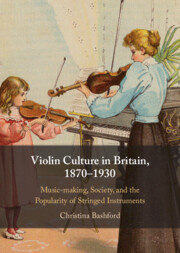 Violin Culture in Britain, 1870–1930
Violin Culture in Britain, 1870–1930 Book contents
- Violin Culture in Britain, 1870–1930
- Violin Culture in Britain, 1870–1930
- Copyright page
- Contents
- Figures
- Tables
- Acknowledgments
- Notes on the Text
- Abbreviations
- Introduction
- 1 Growth of a Culture
- Part I People and Practicalities
- Part II The Conceptual Presence of Strings
- Conclusion
- Select Bibliography
- Index
1 - Growth of a Culture
Published online by Cambridge University Press: 13 September 2025
- Violin Culture in Britain, 1870–1930
- Violin Culture in Britain, 1870–1930
- Copyright page
- Contents
- Figures
- Tables
- Acknowledgments
- Notes on the Text
- Abbreviations
- Introduction
- 1 Growth of a Culture
- Part I People and Practicalities
- Part II The Conceptual Presence of Strings
- Conclusion
- Select Bibliography
- Index
Summary
This chapter sets the scene for readers of the book by defining British violin culture and placing it in historical perspective. It traces the culture’s arc in time by tackling questions of numerical extent, patterns of activity, and related historiographical issues. It also discusses the societal positioning of string players c. 1870 and outlines the socioeconomic factors that triggered the initial surge in learning and playing, including the new availability of cheap instruments and crumbling assumptions about violin playing being out of bounds to women and girls. It ends by tracking Victorian values and activities that persisted from the 1870s into the 1920s – including socioeconomic aspiration, self-betterment, and beliefs in classical music as a meaningful leisure pursuit – to underline the coherence of the book’s periodization. The chapter counters assumptions that the popularity of violin playing was limited to the 1880s and 1890s and further argues that violin culture’s class composition resists generalization.
Keywords
Information
- Type
- Chapter
- Information
- Violin Culture in Britain, 1870–1930Music-making, Society, and the Popularity of Stringed Instruments, pp. 9 - 28Publisher: Cambridge University PressPrint publication year: 2025
Accessibility standard: WCAG 2.0 A
Content Navigation
Allows you to navigate directly to chapters, sections, or non‐text items through a linked table of contents, reducing the need for extensive scrolling.
Provides an interactive index, letting you go straight to where a term or subject appears in the text without manual searching.
Reading Order & Textual Equivalents
You will encounter all content (including footnotes, captions, etc.) in a clear, sequential flow, making it easier to follow with assistive tools like screen readers.
You get concise descriptions (for images, charts, or media clips), ensuring you do not miss crucial information when visual or audio elements are not accessible.
Visual Accessibility
You will still understand key ideas or prompts without relying solely on colour, which is especially helpful if you have colour vision deficiencies.
Structural and Technical Features
You gain clarity from ARIA (Accessible Rich Internet Applications) roles and attributes, as they help assistive technologies interpret how each part of the content functions.